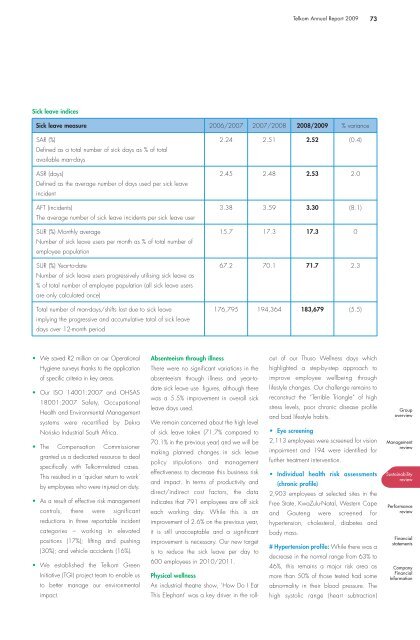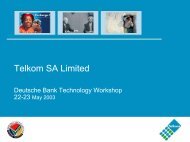Telkom AR front.qxp
Telkom AR front.qxp
Telkom AR front.qxp
Create successful ePaper yourself
Turn your PDF publications into a flip-book with our unique Google optimized e-Paper software.
Sick leave indices<br />
• We saved R2 million on our Operational<br />
Hygiene surveys thanks to the application<br />
of specific criteria in key areas.<br />
• Our ISO 14001:2007 and OHSAS<br />
18001:2007 Safety, Occupational<br />
Health and Environmental Management<br />
systems were recertified by Dekra<br />
Norisko Industrial South Africa.<br />
• The Compensation Commissioner<br />
granted us a dedicated resource to deal<br />
specifically with <strong>Telkom</strong>-related cases.<br />
This resulted in a ‘quicker return to work’<br />
by employees who were injured on duty.<br />
• As a result of effective risk management<br />
controls, there were significant<br />
reductions in three reportable incident<br />
categories – working in elevated<br />
positions (17%); lifting and pushing<br />
(30%); and vehicle accidents (16%).<br />
• We established the <strong>Telkom</strong> Green<br />
Initiative (TGI) project team to enable us<br />
to better manage our environmental<br />
impact.<br />
Absenteeism through illness<br />
There were no significant variations in the<br />
absenteeism through illness and year-todate<br />
sick leave use figures, although there<br />
was a 5.5% improvement in overall sick<br />
leave days used.<br />
We remain concerned about the high level<br />
of sick leave taken (71.7% compared to<br />
70.1% in the previous year) and we will be<br />
making planned changes in sick leave<br />
policy stipulations and management<br />
effectiveness to decrease this business risk<br />
and impact. In terms of productivity and<br />
direct/indirect cost factors, the data<br />
indicates that 791 employees are off sick<br />
each working day. While this is an<br />
improvement of 2.6% on the previous year,<br />
it is still unacceptable and a significant<br />
improvement is necessary. Our new target<br />
is to reduce the sick leave per day to<br />
600 employees in 2010/2011.<br />
Physical wellness<br />
An industrial theatre show, ‘How Do I Eat<br />
This Elephant’ was a key driver in the roll-<br />
<strong>Telkom</strong> Annual Report 2009 73<br />
Sick leave measure 2006/2007 2007/2008 2008/2009 % variance<br />
S<strong>AR</strong> (%)<br />
Defined as a total number of sick days as % of total<br />
available man-days<br />
2.24 2.51 2.52 (0.4)<br />
ASR (days)<br />
Defined as the average number of days used per sick leave<br />
incident<br />
2.45 2.48 2.53 2.0<br />
AFT (incidents)<br />
The average number of sick leave incidents per sick leave user<br />
3.38 3.59 3.30 (8.1)<br />
SUR (%) Monthly average<br />
Number of sick leave users per month as % of total number of<br />
employee population<br />
15.7 17.3 17.3 0<br />
SUR (%) Year-to-date<br />
Number of sick leave users progressively utilising sick leave as<br />
% of total number of employee population (all sick leave users<br />
are only calculated once)<br />
67.2 70.1 71.7 2.3<br />
Total number of man-days/shifts lost due to sick leave<br />
implying the progressive and accumulative total of sick leave<br />
days over 12-month period<br />
176,795 194,364 183,679 (5.5)<br />
out of our Thuso Wellness days which<br />
highlighted a step-by-step approach to<br />
improve employee wellbeing through<br />
lifestyle changes. Our challenge remains to<br />
reconstruct the “Terrible Triangle” of high<br />
stress levels, poor chronic disease profile<br />
and bad lifestyle habits.<br />
• Eye screening<br />
2,113 employees were screened for vision<br />
impairment and 194 were identified for<br />
further treatment intervention.<br />
• Individual health risk assessments<br />
(chronic profile)<br />
2,903 employees at selected sites in the<br />
Free State, KwaZulu-Natal, Western Cape<br />
and Gauteng were screened for<br />
hypertension, cholesterol, diabetes and<br />
body mass.<br />
# Hypertension profile: While there was a<br />
decrease in the normal range from 63% to<br />
46%, this remains a major risk area as<br />
more than 50% of those tested had some<br />
abnormality in their blood pressure. The<br />
high systolic range (heart subtraction)<br />
Group<br />
overview<br />
Management<br />
review<br />
Sustainability<br />
review<br />
Performance<br />
review<br />
Financial<br />
statements<br />
Company<br />
Financial<br />
Information




